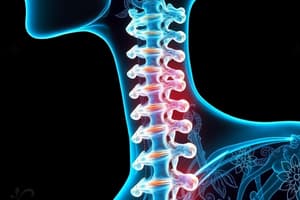Podcast
Questions and Answers
Which joint primarily facilitates rotation in the cervical spine?
Which joint primarily facilitates rotation in the cervical spine?
- Cervical segment 3-4
- Cervical segment 5-6
- Atlanto-axial Joint (correct)
- Atlanto-occipital Joint
Which measurement tool offers a method for objectifying range of motion in the spine?
Which measurement tool offers a method for objectifying range of motion in the spine?
- Sphygmomanometer
- Goniometer (correct)
- Dynamometer
- Electromyograph
What is a key characteristic of the mid/lower cervical spine motion?
What is a key characteristic of the mid/lower cervical spine motion?
- Requires bilateral spine mobility for unilateral motion (correct)
- Single-plane motion dominates the movement
- All planes of motion are independent
- Limited to flexion and extension only
Which of the following factors is NOT typically considered when choosing a measurement method for range of motion?
Which of the following factors is NOT typically considered when choosing a measurement method for range of motion?
The anatomical structure primarily involved in cervical flexion and extension is known as what?
The anatomical structure primarily involved in cervical flexion and extension is known as what?
What is one common aggravating factor that may be assessed during a subjective examination of the spine?
What is one common aggravating factor that may be assessed during a subjective examination of the spine?
Which type of joint is the Atlanto-occipital joint classified as?
Which type of joint is the Atlanto-occipital joint classified as?
Which of the following is an example of a yellow flag screening question?
Which of the following is an example of a yellow flag screening question?
What is the normal range of motion for cervical spine lateral flexion measured in degrees?
What is the normal range of motion for cervical spine lateral flexion measured in degrees?
Which muscle is NOT classified as a capital flexor?
Which muscle is NOT classified as a capital flexor?
What factor primarily limits the flexion-extension movement in the thoracic spine T1-T6?
What factor primarily limits the flexion-extension movement in the thoracic spine T1-T6?
Which anatomical feature contributes to reduced mobility in the thoracic spine?
Which anatomical feature contributes to reduced mobility in the thoracic spine?
Which measurement technique is used to assess the range of motion of muscle activities in the cervical spine?
Which measurement technique is used to assess the range of motion of muscle activities in the cervical spine?
Which of the following conditions could be indicated by weakness of capital extensors?
Which of the following conditions could be indicated by weakness of capital extensors?
Which thoracic vertebrae have a horizontal orientation of spinous processes?
Which thoracic vertebrae have a horizontal orientation of spinous processes?
What challenge is associated with isolating lumbar and thoracic range of motion measurements?
What challenge is associated with isolating lumbar and thoracic range of motion measurements?
What is the primary measurement tool for flexion in thoracolumbar range of motion?
What is the primary measurement tool for flexion in thoracolumbar range of motion?
What factor limits lateral flexion and rotation in the lumbar spine?
What factor limits lateral flexion and rotation in the lumbar spine?
During thoracolumbar rotation across the normal range, what is the typical degree of rotation considered normal?
During thoracolumbar rotation across the normal range, what is the typical degree of rotation considered normal?
Which way is the lumbar spine classified in terms of motion relative to sidebending?
Which way is the lumbar spine classified in terms of motion relative to sidebending?
What is the specific interrelation referred to when discussing the movement between the spine, pelvis, and hip during lumbar flexion?
What is the specific interrelation referred to when discussing the movement between the spine, pelvis, and hip during lumbar flexion?
Which measurement device is NOT typically used in lumbar ROM assessments?
Which measurement device is NOT typically used in lumbar ROM assessments?
In the thoracic spine, which region is generally associated with greater sidebending than flexion/extension?
In the thoracic spine, which region is generally associated with greater sidebending than flexion/extension?
What is a common compensation observed in thoracolumbar rotation measurements?
What is a common compensation observed in thoracolumbar rotation measurements?
Flashcards are hidden until you start studying
Study Notes
Spine Examination
- Examination of the Spine involves assessing the cervical, thoracic, and lumbar spine, as well as the temporomandibular joint (TMJ).
- Subjective Examination begins with gathering information about the patient's symptoms, including location, aggravating and alleviating factors, pain pattern, time frame, chronicity, prior history, work/family responsibilities, and yellow/red flag screening.
- Objective Examination includes assessing the range of motion (ROM) of the spine using tools such as a goniometer, inclinometer, and tape measure.
- Cervical Spine ROM typically includes flexion (45 degrees or 2 cm), extension (45 degrees or 20 cm), lateral flexion (45 degrees or 11 cm), and rotation (60 degrees or 12 cm).
- Capital Flexors include muscles like the rectus capitis anterior, rectus capitis lateralis, and longus capitus. Deep palpation of these muscles is not recommended due to the presence of the carotid artery.
- Thoracic Spine ROM is generally less mobile than cervical and lumbar due to the orientation of facets and the presence of ribs.
- Lumbar Spine ROM is measured in various ways, with landmarks used to determine the joint's position and movement.
- Lumbopelvic Rhythm refers to the coordinated movement of the spine, pelvis, and hip during lumbar flexion.
- Thoracolumbar ROM measurements include flexion, extension, lateral flexion/sidebending, and rotation.
- Thoracolumbar Rotation is measured while seated, with the feet and knees together, arms holding a bar or stick behind the shoulders. Normal rotation is around 45 degrees.
Spine Anatomy
- Atlanto-occipital Joint (AO): a synovial joint located between C0 and C1, responsible for flexion and extension (nodding "yes"). Average ROM is 20-30 degrees.
- Atlanto-axial Joint (AA): a synovial joint located between C1 and C2, primarily responsible for cervical rotation, contributing to over 50% of the total cervical spine rotation.
- Mid-lower Cervical Spine allows movement in three planes: flexion/extension, rotation, and sidebending.
- Thoracic Spine (T1-T6): facets are oriented in the frontal plane, limiting flexion-extension and encouraging sidebending. The presence of ribs and costal joints further restrict lateral flexion.
- Thoracic Spine (T7-T12): facets are in the sagittal plane, allowing more flexion/extension than sidebending.
- Lumbar Spine (5 vertebrae): Spinous processes are horizontal, facets are in the sagittal plane, allowing greater flexion/extension and some sidebending and rotation.
Spine and Neurovascular Structures
- Cervical Spine Weakness of Capital Extensors: may indicate a non-patent airway or an inability to swallow.
- Thoracic Spine can be affected by internal organ issues.
Studying That Suits You
Use AI to generate personalized quizzes and flashcards to suit your learning preferences.




